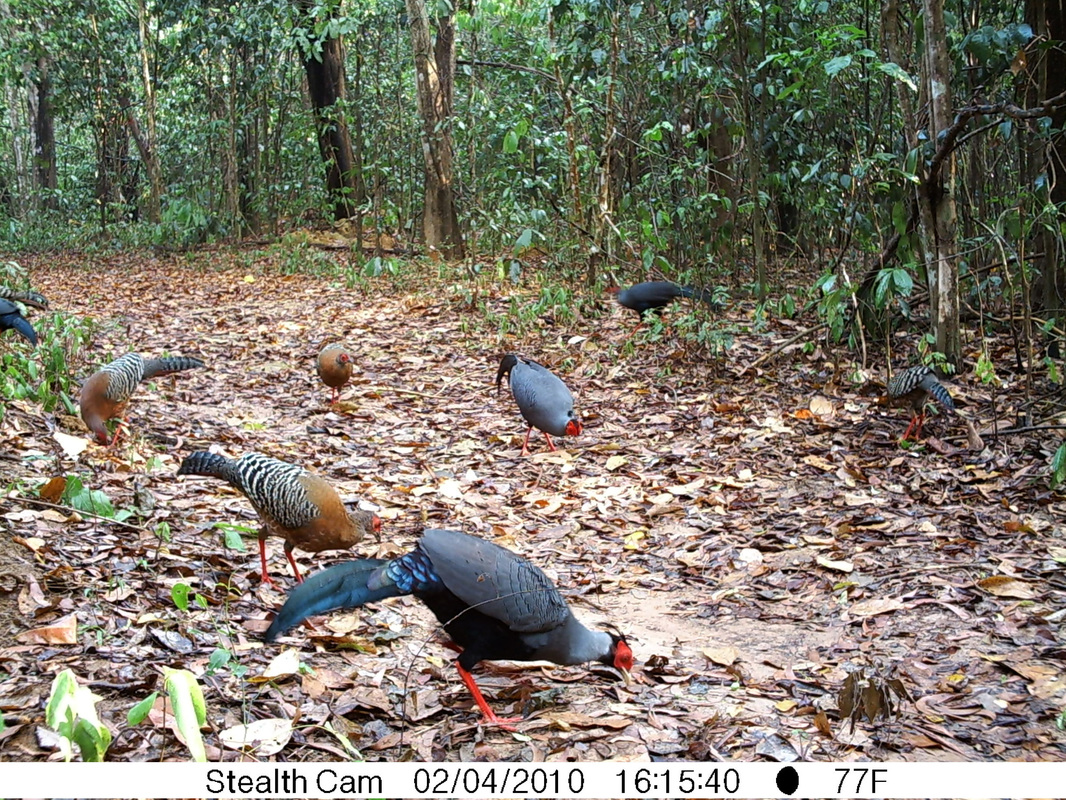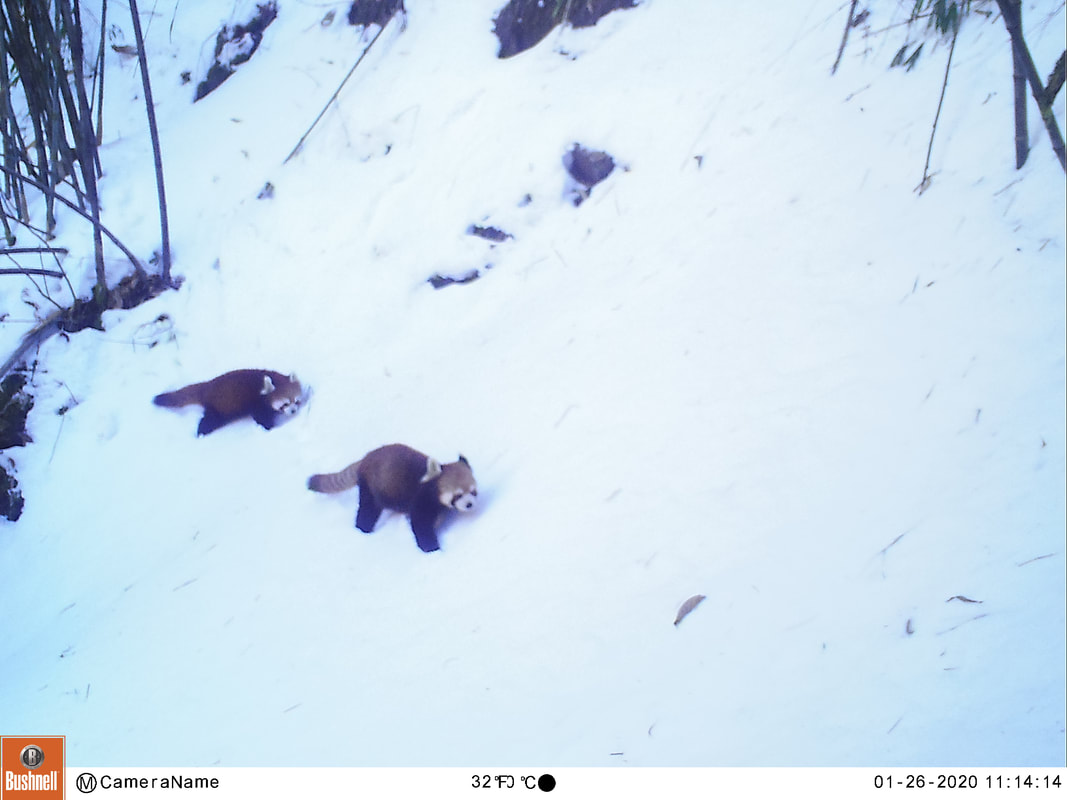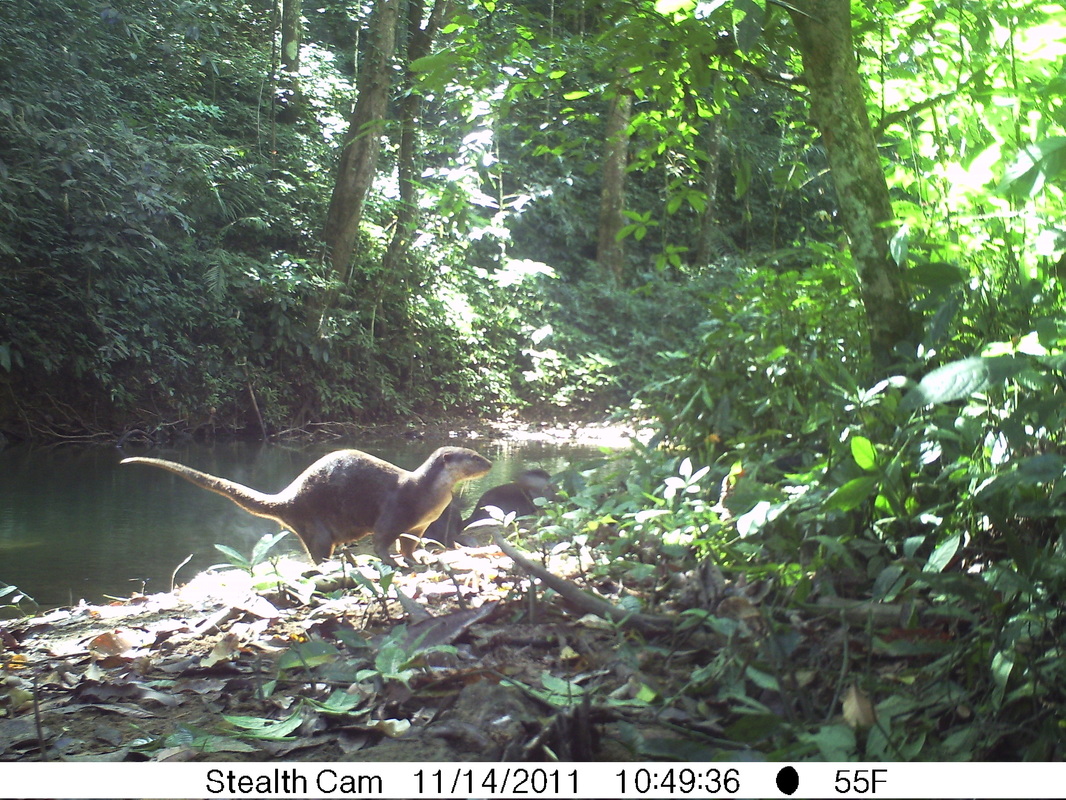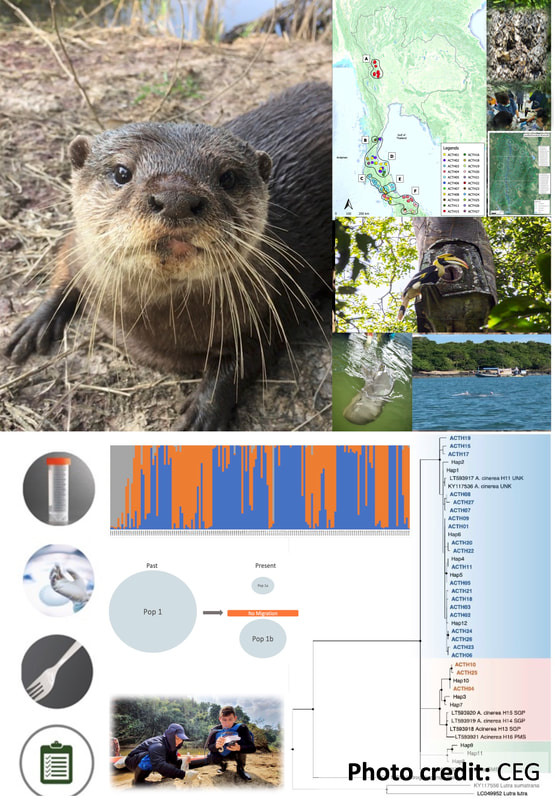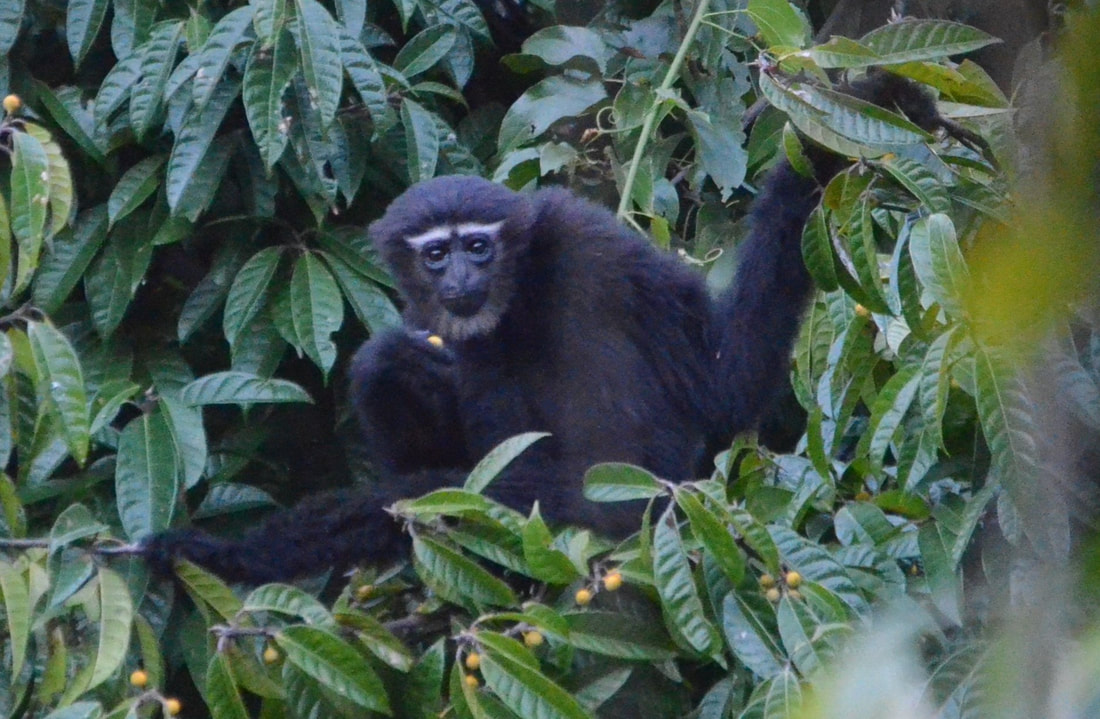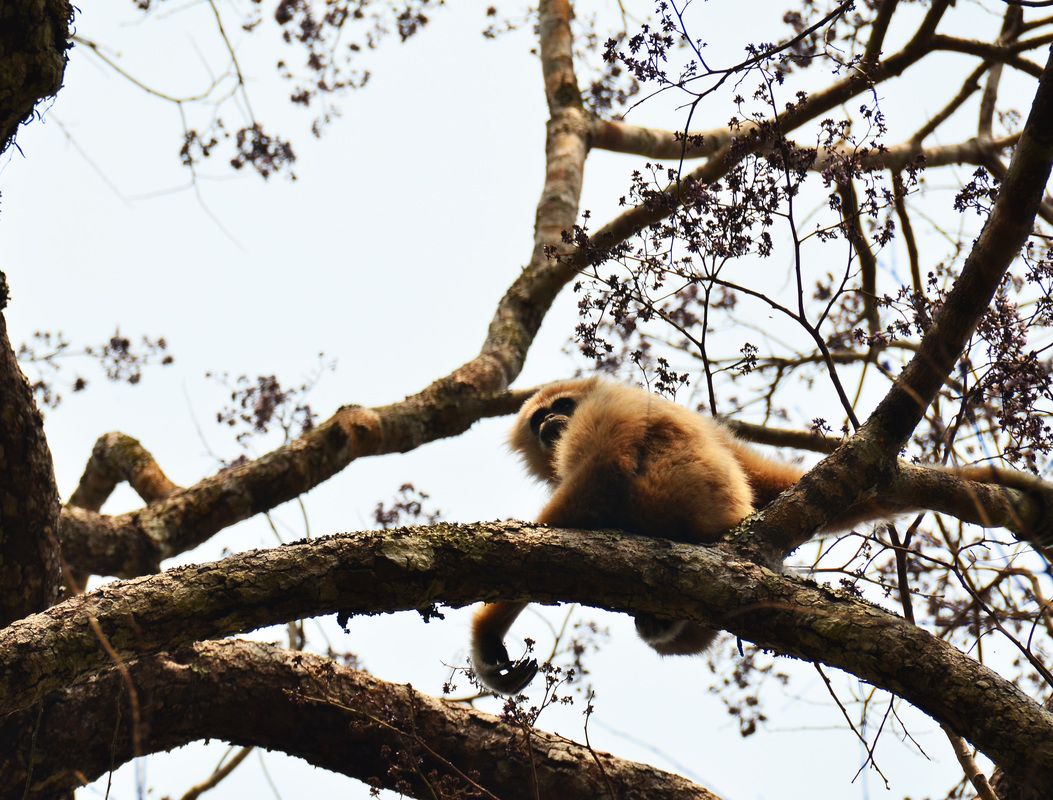Protection of threatened species and habitats
The past 500 years have seen human-induced species loss that rivals or surpasses the great extinctions of ages past both in terms of magnitude and rate of declines. Most species live in rapidly fragmenting communities, and loss of one species has subsequent impact on the persistence of others through trophic cascades. It is therefore important to know which species are most at risk, the ecosystem services they provide, and to develop strategies for protection.
The lab currently studies four main groups of threatened taxa: primates, galliformes, large carnivores including bears, and small carnivores. A significant problem for Southeast Asia is that basic population data is largely absent for many threatened species. Conservation measures often start with population estimates, which for many species viability estimates are still basically guesswork. Thus, one of the lab's primary goals is to start putting scientific rigour into population estimates, along with habitat models to try to estimate global population sizes and trends of those populations. In conjunction with this, at the site level, adequate techniques often do not yet exist for estimating abundance, and thus the lab is involved in developing new techniques, adapting established techniques, and testing and comparing survey methods to best estimate abundances of these threatened taxa. In addition, the programme has an interest in seed dispersal, a critical ecosystem function for forest dynamics that many of these focal species provide, particularly primates, bears, birds, and small carnivores such as civets. Finally, there is also a new focus on trophic level issues starting with small carnivores and the role they play in ecosystem function and the factors that control their population dynamics, such as top-down control by large carnivores and bottom-up control through food availability such as fruit and rodents. |
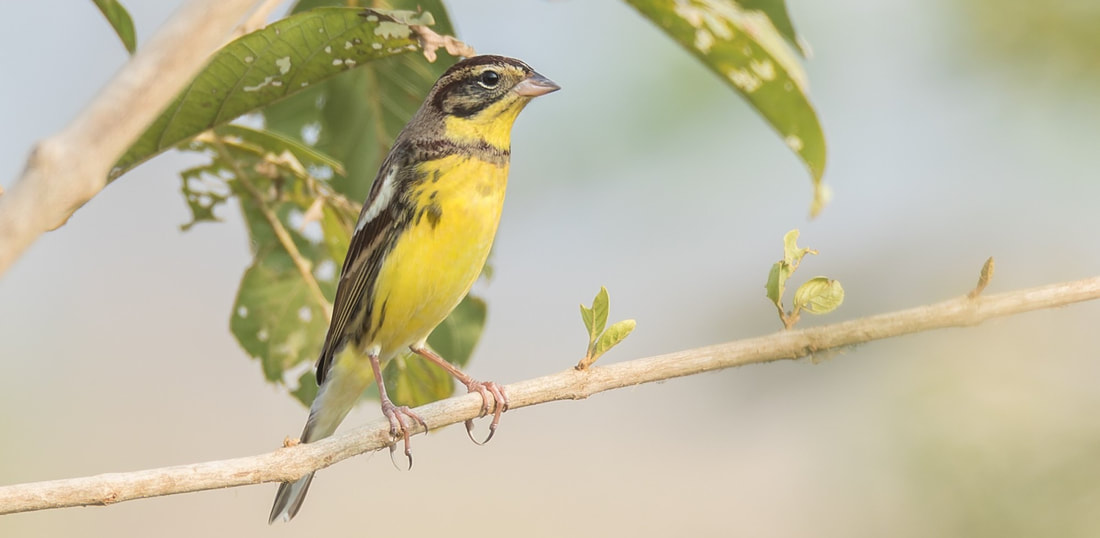
Adult male Yellow-breasted Bunting (Emberiza aureola), a Critically Endangered species, in non-breeding plumage from a day roost. Ongoing PhD research focusing on this species has discovered more than 10000 individuals in one of the key wintering sites at Kaeng Lawa. Khon Khaen Province. Photo credit: W. Limparungpatthanakij, 2020
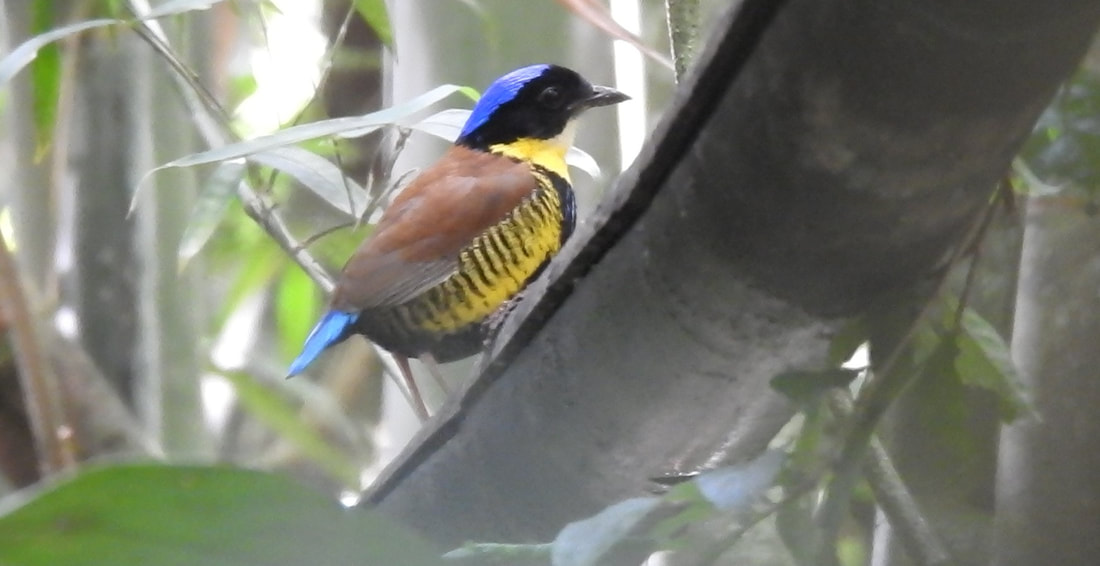
Gurney’s pitta (Hydrornis gurneyi), limited to extreme lowland evergreen forest of Southern Myanmar and Thailand, has seeing its habitat shrinking by 88%, with only 476 km2 of large patches, remaining in Myanmar and almost entirely disappear in Thailand. As a consequence, the species was recently downgraded to Critically Endangered. Credit: N.M. Shwe & FFI

Among the largest remaining mangrove forest patches, the Sundarbans host a large Bengal tiger population which is under major threat. Research on the Bangladesh part (6,000 km2) assessing tiger status, their habitat selection and quantify the overall threat to biodiversity aimed to assist management. Credit: T. Savini
|

A detailed survey of forest partridge above (KangKrachan Forest complex) and below (KhlongSaeng-KhaoSok Forest complex) the Isthmus of Kra has not recorded any of the 6 species that should inhabit the area, with the exception of a small remaining populations of Ferruginous partridge (Caloperdix oculeus) found in low density. This alarming result could be the consequence of past high hunting pressure. Credit: S. Raksue (with permission)
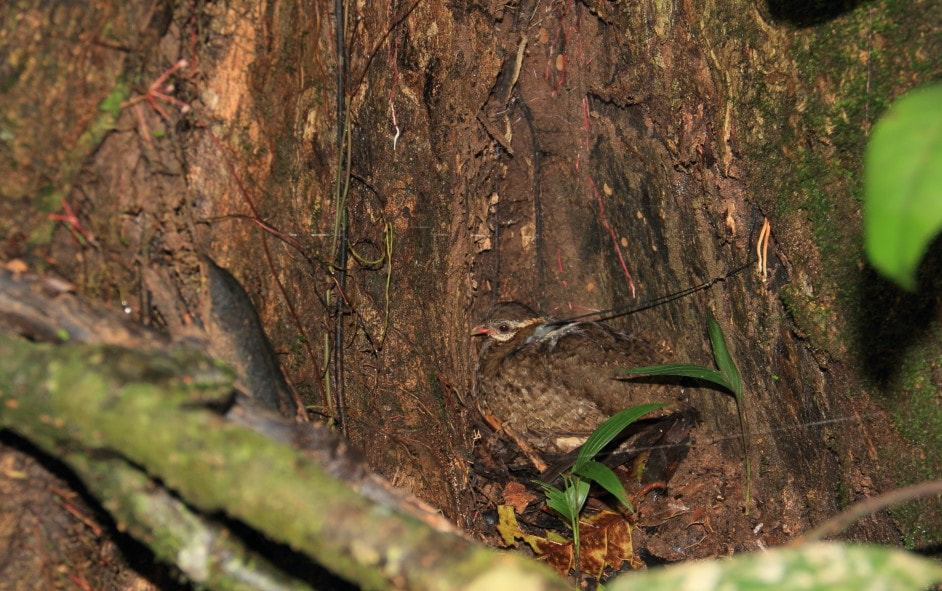
Despite being distributed over most of mainland southeast Asia, where it is rather common, scaly breasted partridge (Tropicoperdix chloropus), like most forest partridges in the region, are poorly known. Extensive ecological work focusing on the species ranging behavior, home range size, habitat use and nesting behavior has been carried out in Khao Yai National Park (Thailand), using radio collared animals. Credit: T. Ong-in
|
Southeast Asian Galliformes: status and conservation
With 25% of their species threatened, Galliformes are under major pressure from human disturbance. Relatively well studied in China and the Indian subcontinent, basic data is still lacking on most of the species/genera inhabiting southeast Asia, which impedes the effectiveness of conservation management efforts. Important conservation questions include distribution status, population trends, and hot-spot areas for species protection.
The Conservation Ecology Program is addressing Galliforme conservation in a number of ways. This includes regional, landscape-level investigations of species distribution and status using predictive mapping, and using up-to-date survey methods adapted to both loud calling and cryptic species. Studies are underway, and have been completed, on key threatened species from all the available genera, investigating ecological parameters such as nesting, predation avoidance, ranging behaviour and micro- and macro-habitat selection. When possible, comparison of the current status with past datasets is needed to define population/species trends, and remote sensing is used to look at long-term habitat loss, degradation, and to highlight where further survey or strengthened management/outreach should take place. 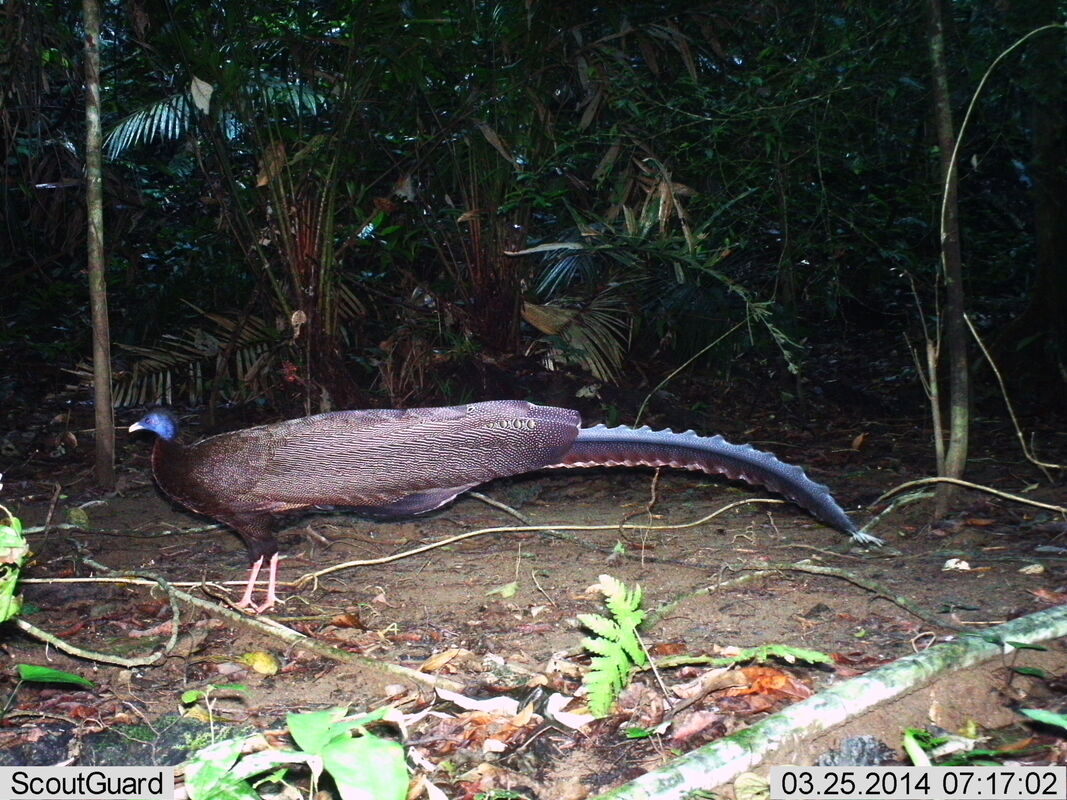
The largest ground bird in the evergreen forest of Southern Thailand, great argus (Argusianus argus) appear to be quite resilient to disturbance and hunting pressure. However, the species is negatively impacted by forest edge effect, both from agricultural areas and artificial reservoirs. Credit: T. Dawrueng
|
Small and meso-carnivore conservation
Most mammalian research focuses on large, charismatic predators. However, Southeast Asia is also a vitally important region for the conservation of meso- and small mammalian carnivores, with several endemic and globally threatened species. A recent status and distribution assessment suggests that Thailand is likely of comparably higher global significance for the conservation of these species as they are still relatively abundant and recorded across several protected areas. Hence, the major questions of interest among conservationists include the distribution and status of meso- and small mammalian carnivores, localities requiring strengthened protection to ensure their survival, and ecosystem services provided.
It is increasingly evident that the best hope for some species lies in the conservation of unprotected or underprotected habitats which lack large apex predators. In these systems, small carnivores assume the position of the top carnivores. Wetland habitats are particularly crucial for survival of species such as Small-clawed Otter (Aonyx cinereus), Smooth-coated Otter (Lutrogale perspicillata), Hairy-nosed Otter (Lutra sumatrana), Fishing Cat (Prionailurus viverrinus), Flat-headed Cat (Prionailurus planiceps), and Otter Civet (Cynogale bennettii). Habitat loss and degradation is likely threatening these species survival as well as the overall integrity of their ecosystems through trophic cascade. Much of the Programme's recent work has focused on conducting camera-trap, key-informant interviews, and animal sign surveys in underprotected wetlands, coastal habitats, and urban areas. Ecological studies and interactions among sympatric mammal species are also studied. In terrestrial habitats in locations such as dipterocarp mosaics of eastern Cambodia and forest fragments across the region, small and meso-carnivores serve as top predators. As with systems hosting large carnivores, it is important to understand the interactions among species and influence of dynamic resource availability in determining species habitat use and population trends. Yet, basic ecology of most of small carnivores, in particular threatened species such as Large-spotted Civet (Viverra megaspila), are still lacking in most parts of their ranges. The Conservation Ecology Program is addressing these questions in several locations. Both in wetland and terrestrial habitats, the programme is also working to identify long-term conservation hotspots and baseline data for population assessments, which should also benefit these species regionally. |
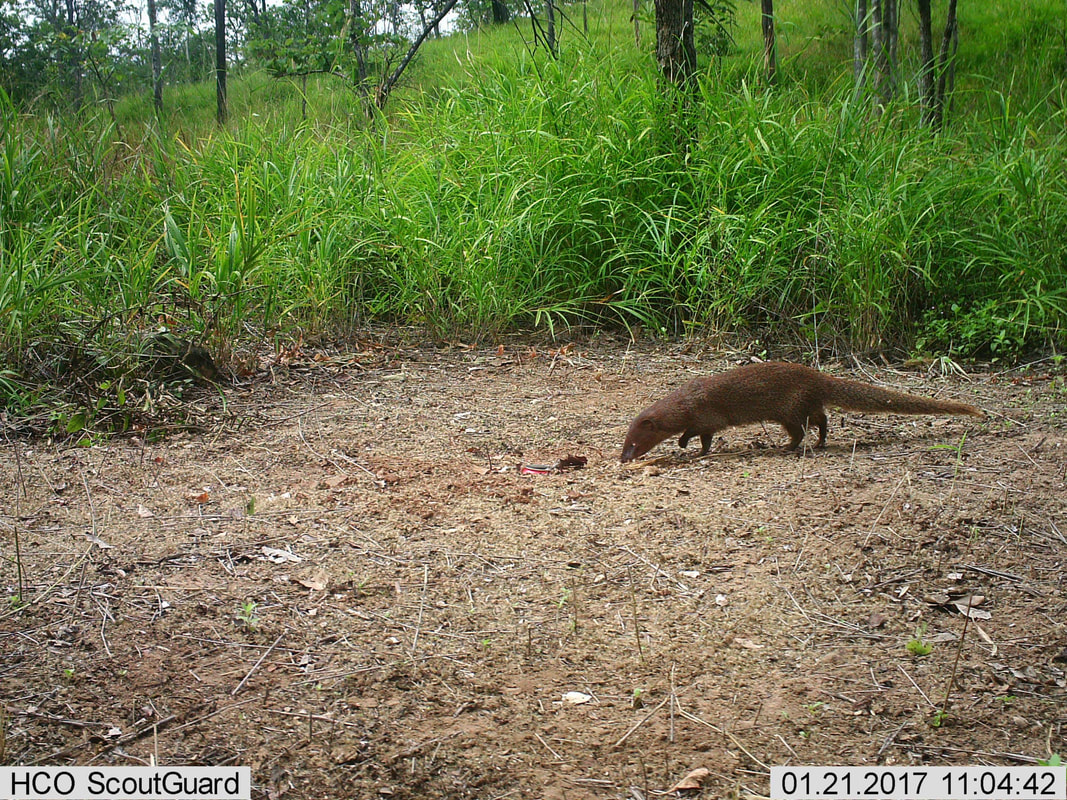
Highly overlooked small forest fragment, as the Sakaerat Biosphere Reserve, can offer valuable habitat for small carnivores. Investigating the status of leopard cat (Prionailurus bengalensis) and small Asian mongoose (Herpestes javanicus) confirmed the conservation importance of the area.
Photo, small Asian Mongoose from camera trap. Credit W.J. Petersen.
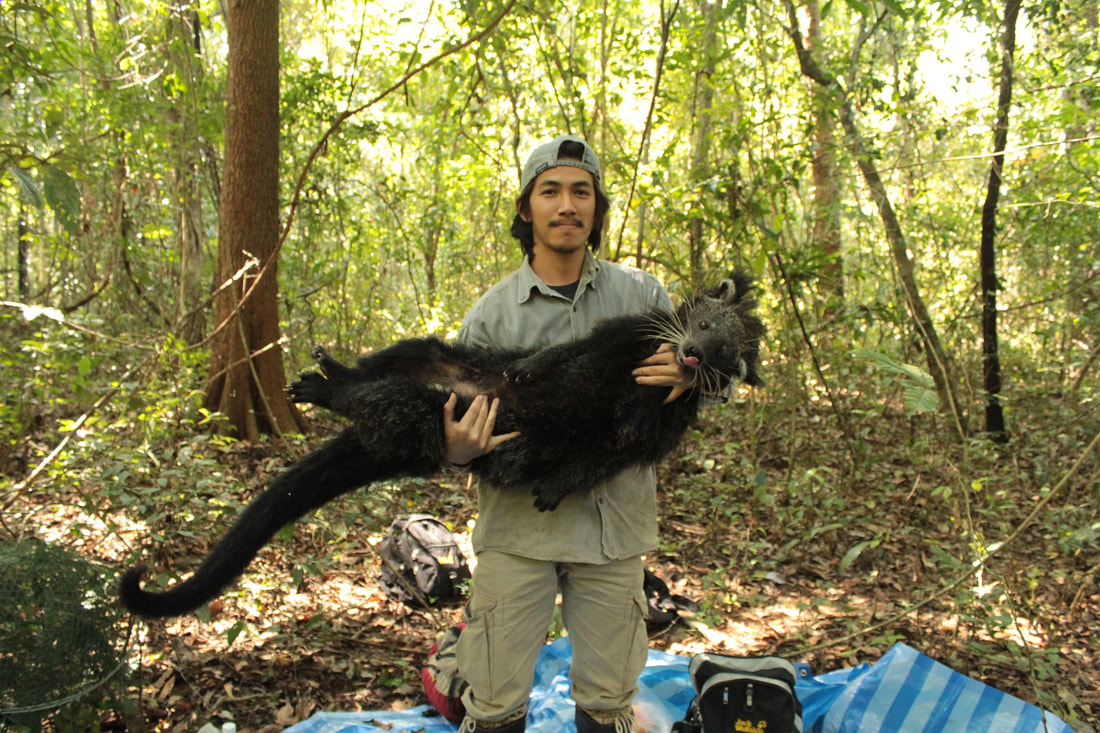
Research assistant A. Kamjing carried a sedated female binturong (Arctictis binturong, nick named ‘Nong Poy’), who was fitted with radio collar, as part of a study of home range and habitat use of small mammalian carnivores in Thung Yai Naresuan Wildlife Sanctuary (west), Thailand, between 2009 and 2012. Credit: W. Chutipong
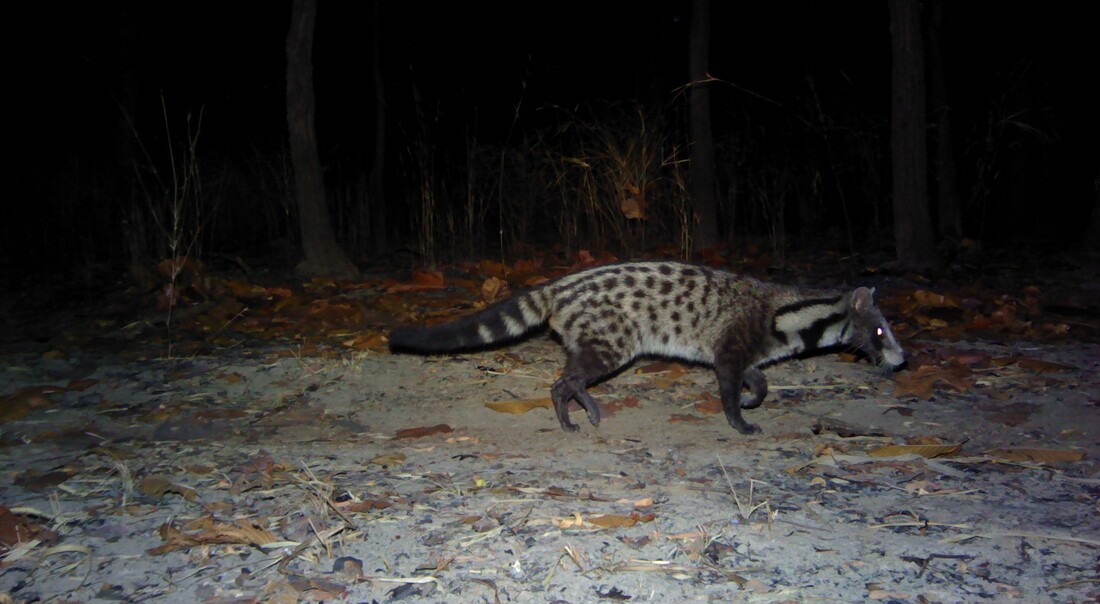
The Endangered large spotted civet (Viverra megaspila) is still relatively unknown, making difficult their management. Using camera traps, ongoing PhD research estimates the species density and interaction with other small carnivores, particularly large Indian civet (Viverra zibetha), in the Eastern Plains Landscape and the Northern Plains Landscape of Cambodia, predominantly covered by deciduous dipterocarp forests. Credit: C. Pin
|
Conservation genetics
Insights into phylogeographic partitioning, metapopulation dynamics, and the source populations of illegally traded animals
We explore how evolutionary and ecological processes have shaped the spatial distribution of biodiversity. We apply population and evolutionary genetics to address the biodiversity crisis, identify populations at risk, and inform conservation management for threatened species.
Our research focuses on promoting population recovery and species persistence through a better understanding of changes in genetic diversity, connectivity, and demography over time. Through phylogenetic analyses, population genetics, spatial statistics, Sanger and High-throughput sequencing approaches, we quantify and tease apart the impacts of historical environmental changes including geological events and climatic fluctuation from those of the more recent human disturbances on phylogeographic partitioning, population genetic diversity, connectivity and effective population sizes. To facilitate population monitoring of rare, elusive, wide-ranging species, we are developing practical noninvasive sampling techniques, enabling genetic data extraction at a landscape scale from fecal, hair, feather, and water samples. Our primary research areas include: (1) Illegal wildlife trade monitoring: tracing the geographic origins of illegally traded Asian small-clawed otters and Smooth-coated otters in Thailand and Japan using developed genetic references of wild populations in Thailand and genetic assignment tests. (2) Genetic management of captive birds and mammals: evaluate the ongoing captive breeding practices and design founder pairing plans to maintain genetically diverse populations of captive Great hornbill, Oriental pied hornbill, fishing cat, Banteng, Fea’s muntjac, Green and Hawksbill turtle. (3) Population genetic monitoring in human-dominated landscapes: assess the impacts of human activities and captive breeding practices on genetic diversity and structure of host (otters, hornbills) and microbial communities (gut microbiome in captive elephants) (4) Phylogeographic inference: assess the impacts of historical environmental factors on spatial genetic distribution of otters, hornbills, and sea turtles. (5) Molecular detection of marine vertebrates using qPCR, metabarcoding, High-throughput sequencing: increase detection of bony fish communities and marine mammals via our developed eDNA assays. |
